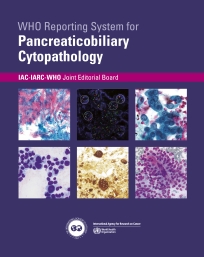
978-92-832-4518-6
The WHO Reporting System for Pancreaticobiliary Cytopathology is Volume 2 of this new series of reporting systems for cytopathology, which is a joint project of the International Academy of Cytology (IAC) and the International Agency for Research on Cancer (IARC), a specialized agency of the World Health Organization (WHO). The series includes a unique synthesis of the published evidence and the practice of cytopathology, and it is linked to the WHO Classification of Tumours series, now in its 5th edition.
Cytopathologists look at tumours slightly differently than other specialists do, and there is a need for specialized reporting systems based on the key diagnostic cytopathological features of tumours, presented in standardized reports, within a hierarchical system of diagnostic categories. These categories must also be linked to diagnostic management recommendations to improve communication with clinicians and support patient care. And it is essential that these reporting systems be truly international, to serve the needs of patients worldwide in many differently medically resourced settings.
What are the key features of this first edition of the series?
These volumes are an essential tool for standardizing diagnostic cytopathology practice worldwide and will serve as a vehicle for the translation of cytopathology research into practice. The key diagnostic cytopathological features are listed for each tumour type under a defined set of diagnostic categories and described in precise, uniform language. These diagnostic criteria represent the first international consensus and are underpinned by evidence that has been evaluated and debated by experts in the field. Each lesion-specific section includes a dedicated subsection discussing the differential diagnosis of the cytopathological features that can be used throughout the world, including in low-resource settings, followed by a subsection describing the current best-practice application of ancillary testing (including next-generation sequencing) on cytopathology material.
This volume
Online version
The content of this new, innovative, and comprehensive cytopathology reporting series is also available in a convenient digital format, at https://tumourclassification.iarc.who.int
No corrigenda for this volume to date